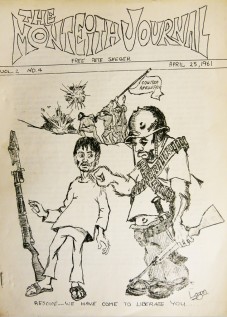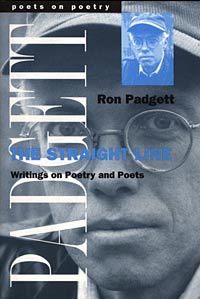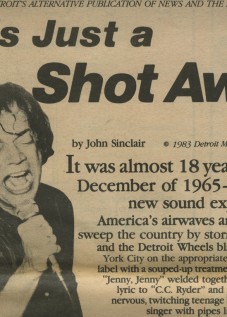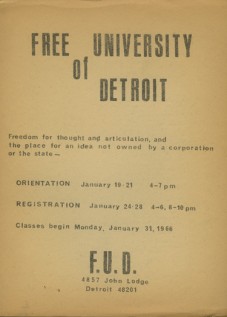Olson’s Universe
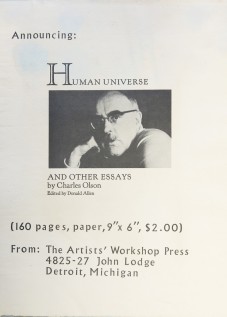
Human Universe by Charles Olson announcement, AWS press
OLSON’S UNIVERSE;
CREELEY, ORIGIN & BLACK MOUNTAIN COLLEGE
by Cary Loren, 2004
In the land of plenty, have
nothing to do with it
take the way of
the lowest,
including
your legs, go
contrary, go
sing
– Charles Olson, Maximus 4, Song 3
THE ROAD TO PROJECTIVE VERSE
Olson was furious with Pound’s politics and his vapid racism, but still viewed him as a father figure: in a larger literary sense, the papa of new American poetry. Olson had to get out, to find himself. The only possibility was to metaphorically kill the father,[i] and in doing so, renew himself. Pound’s metaphorical death was his transformation. Olson adopted and used Pound’s Vortex into a major poetic theory; replacing vortex with centeredness, from Olson’s ‘The Gate and the Center’: “What I am kicking around is this notion: that KNOWLEDGE either goes for the CENTER or it’s inevitably a State Whore – which American and Western education generally is, has been, since its beginning.”[ii] Olson begins with an archeological dig—a dig deep into language and mythology, beginning with Fenollosa: Take language (& start with Fenollosa) – his theory continues with civilization’s wrong turn in support of the hero: What I’m tiring to crack down is, heroism. … man’s capacity to overthrow and dominate external reality. Olson’s conclusion replaces the “hero” with self-directed energy and nature’s forces at the center of knowledge. The center was regional, where all things were.
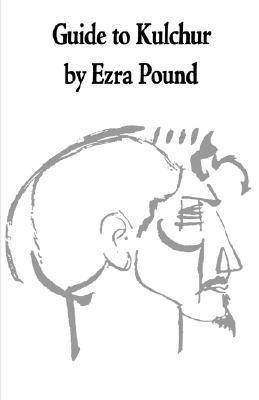
Ezra Pound’s Guide to Kulchar, New Directions, 1938
His essential manual of poetry, the polemic ‘Projective Verse’ was a found transformation, again from Fenollosa through Pound. Louis Zukofsky another early modernist—also saw language as history, but seemed to be cut out of this connective tissue (a writer who was there, but stranded). The year 1950 would be major for Olson. He would began a monumental correspondence with the poet Robert Creeley, begin discussion’s with Cid Corman on their collaborative literary journal Origin, and compose his double guideposts of new poetry: ‘The Gate and the Center’, and ‘Projective Verse’.
Creeley was twenty-three at the time of his and Olson’s correspondence; world-wise and inspired by be-bop and the hipster lingo of black jazz musicians. “In strategic terms, for Olson, the greatest value of his association with Creeley lay in the simple fact of having someone with whom to promote a shared agenda (Zukofsky had no one). One could not start a revolution alone.”[iii] Creeley’s vigor and sketch-pad language was an intoxicant for Olson. They both screwed with language and convention, finding a new path, and came to it from different angles. Creeley articulated for Olson the origin of sound and music they both had discovered along separate paths: “all the close friends thru the college yrs, and later: were musicians or making sounds, etc. It was a shortcut to speech, understanding, to make use of the words running with same/ or: the worst, crazy, too much, gone, the thing, goofed, in his crib, dig, etc…. Of course for ways in speech, sounds & timing: there is nobody like, say, the colored: negroes: a rhythm & a feel for each thing that comes out of their mouths. That wd take some time to document, like they also say.”[iv] Creeley would send lists of what to listen: Miles Davis: Complicity, Move; Charlie Parker: Chasing the Bird, Cheryl, Don’t Blame Me; Bud Powell, Max Roach, Milt Johnson, Al Hag, etc. –jazz expressing another sound form of kinetics in poetry—an idea out of Pound overlaid onto bop. The culture of Black vernacular and jazz was a monumental force on poetics.
Olson pushed ideas into his emergency room mode of thought and action. Letters were thrown like grenades between him and Creeley. “The poem itself must, at all points, be a high-energy construct and, at all points an energy discharge,” said Olson.[v] There is an extreme urgency and need for speed that Olson saw as the way to address the modern condition. The original form of ‘Projective Verse’ was adjusted, tweaked and worked over through letters with Creeley. Olson pulled from Creeley a key line; “to make it clear: that form is never more than an extension of content.”[vi] Olson’s life was focused on a single directive: to pass on a theory of poetics that would have a far-reaching influence on culture. One short essay, first published in Poetry New York (1950) would become his most important and quoted statement.
An analysis of Olson’s ‘Projective Verse’ is covered by Paul Christensen’s study: Charles Olson: Call Me Ishmael. In this excerpt, Christensen sees Olson’s 119 page book Call Me Ishmael as: “…the result of fourteen years of intermittent scrutiny, and the argument reads as though each step of his complex thought had been trimmed to the essentials and then stitched very deliberately into sequence. The prose never flows, it leaps from one moment of close concentration to the next; our attention is always focused on a series of details as a thesis is fashioned that explains and integrates them. At no time are we allowed to relax with a broad overview of the whole novel, nor are we given clear signs of where the next step will lead us. The effect is that of being led quickly through the stages of a revelation that Olson suspends until the last sentence.”[vii] Olson was building a narrative using his high-energy construct. The reader becomes propelled like a canon shot through the ideas and theories presented. It was the physical reality of the theory: one perception must immediately lead to another.
The famous ‘Projective Verse’ essay first published in Poetry New York in 1950, gathered dust for 10 years, slowly gathering fame. William Carlos Williams wrote him soon after publication and called it “keystone” and “the most admirable piece of thinking about the poem I have recently, perhaps ever, encountered”… When published in Donald Allen’s Anthology of New Poetry (1960), ‘Projective Verse’ was the lead chapter opening the book and immediately drew a mass audience. It was a smash. In this excerpt from ‘Projective Verse’ Olson discusses the process of poetry as a sequence of progressions:
“…I think it could be boiled down to one statement (first pounded into my head by Edward Dahlberg): ONE PERCEPTION MUST IMMEDIATELY AND DIRECTLY LEAD TO A FURTHER PERCEPTION. It means exactly what it says… get on with it, keep moving, keep in, speed the nerves, their speed, their perceptions, theirs, the acts, the split-second acts (the decisions you make while scribbling), the whole business, keep it moving as fast as you can, citizen. And if you set up as a poet, USE,USE,USE the process at all points. In any given poem always, always, one perception must, must, must (as with the mind) MOVE INSTANTER ON ANOTHER!.. so there we are, fast there’s the dogma. And its excuse its usableness, in practice. Which gets us… inside the machinery, now, 1950, of how projective verse is made.”[viii]
Elements of “Projective Verse” can be seen illustrated in the early imagist poetics of Pound and his kinetic ideas based on Chinese calligraphy. The concept of “open verse” or “field verse” is shown in early Chinese paper collage and scroll calligraphy. The ideograms, and picture-based languages are all “open field” poems. Imagist poets (Pound, William Carlos Williams, H.D.) broke down and revolted against over-done adjective-prone symbolist poetry. The imagists wanted to speak directly to the vision. Pictoralism was an artistic relative to imagism that made the image understood in flashes of awareness. The pictoralist movement and photo-secessionists also sprang out of symbolism, and under the tutelage of Alfred Stieglitz, became a worldwide practice; a photography movement focused on moments of poetic illumination and symbols.
Sound and breath control (Ezra Pound’s How to Read) is further explored by Olson, and a technique unknowingly practiced by almost all performing poets today, (whether they realize the reference or not). Olson was able to find in the mechanics of typewriting, various keys and design that could control syntax and breath—in unison to move meaning forward in the poem. Pound earlier saw the Projective Verse effect pronounced in syllable placement and selection while researching Chinese ideograms for Ernst Fenellosa. From Pound to Olson to Ginsberg as Ed Sanders once pointed out.[ix] Olson’s comments on this integral theme of breath and poetry structure, have had a lasting effect on contemporary poets: “And the line comes (I swear it) from the breath, from the breathing of the man who writes, at the moment he writes, and thus is, it is here that, the daily work, THE WORK, gets in,” he continues this analytic breakthrough in spoken word, “Because breath allows all the speech-force of language back in (speech is the solid of verse, is the secret of a poem’s energy…)”[x] Use of these elements; line, structure, syllable and breath is hammered down in ‘Projective Verse’; “If a contemporary poet leaves a space as long as the phrase before it, he means that space to be held, by the breath, an equal length of time. If he suspends a word or syllable at the end of a line (this was most Cummings’ addition) he means that time to pass that it takes the eye—that hair of time suspended—to pick up the next line…. Already they are composing… as though not the eye but the ear was to be its measurer…”[xi]
LETTERS TO ORIGIN
In 1950, the poet Cid Corman was twenty-six years old, living with his parents outside of Boston when he began a correspondence with Olson with the idea of publishing a literary magazine. The letters lobed between Corman and Olson would result in Origin, a magazine “which has helped raise, redefine, and direct the course of American poetry in this century.”[xii] Origin published some of the most seminal poets of the time with an agenda that focused on the Creeley/Olson circle including; Robert Duncan, Denise Levertov, Paul Blackburn, William Bronk, Gary Snyder and Larry Eigner. Origin became a mouthpiece for ‘Projective Verse’ writing, immediately after Olson sent Corman a copy of the essay. Olson was able to shape and influence the journal’s direction as he prodded and pushed the inexperienced Corman across a twelve page letter: “do you cid corman, think that you can put out a PUSH, now, by not following up on the FIRST PRINCIPLE (non-deductive, but formal totality of a man, say, in each issue) to the SECOND PRICIPLE, the same, from p.1 to page 75 (you say) AS OF THE WHOLE REALITY NOW?” Olson fired off objections to Corman’s inclusive global attitude about contributors:
“WHAT SELECTIVE
PRINCIPLE IS THERE, the equal of, GETTING
IN THE GOIng ENERGY OF THIS PRESENT – here and now, US 1951 – for A MAG?
((is your “taste” in prose or verse – or mine ( on quality
level) as inTERESTING? as IMPORTANT as an attempt to do
just that?
TO GIVE IT, AS FAR AS YOUR LIMITS GO, not
taste, but ENERGY?…
KNOWLEDGE, lad, is what art and culture BUILD ON”[xiii]
Olson’s letters, structured as poems, at times were bullying and manipulative, yet after a single goal: “You are a great fool Corman.. You are really quite stupid… You had nothing to fear and all to gain. That is, if you did not so palpably fear you have no taste at all. But where do you think taste and judgment come from? They are earned, and it is not the least way to earn taste than from your betters- especially, when such are ready to give you the best of themselves… It is altogether LOSS, Corman. …
Look, lad, get off the pot.
You want to do a job? Then,
stop fucking yourself.”[xiv]

Sid Corman: Origin #1, 1951 which contained the first excerpt of Olson’s epic Maximus
After reading Projective Verse, Corman replied, “I don’t think it farfetched to say that all the work I’ve accepted for inclusion for #1 is PROJECTIVE… Would like your permission to consider your PROJECTIVE ideas as an important facet of mags direction.”[xv] Corman and Olson wanted Origin to be read and organized round the principle of a single idea, a novel aim for an experimental journal. Early trial names for the journal were Spring, Source and re/SOURCE. It was a journal “designed FOR the creative reader… My kick is always this: less theory and talk, and more event, more action… I am sick of gestures. ORIGIN will not live on gestures. Why do I rave to you? Well, probably because you recognize as well as any the values of ORIGIN and what it can and shd be. There aren’t many that do,”[xvi]
Olson’s tone and temper settled down after the publication of Origin #1. He wrote to Corman his glowing response in his opening sentence: “the fullest satisfaction I have ever had from print, lad, the fullest. And i am so damned moved by yr push, pertinence, accuracy, taste, that it is wholly inadequate to say thanks.”[xvii] Olson continues for seven pages congratulating Corman and offering improved suggestions for the magazine. Olson could be amazingly generous in his praise as he could be curt and razor-sharp in his criticism.
Corman’s reflection of their relationship was made throughout his introduction his anthology, The Gist of Origin: “As I have often had cause to remind others as well: it is tough to hear what someone is saying when he is shouting all the time. Olson was very much in the hortatory line of Lawrence and Pound.”[xviii] Corman stuck to his program, often concentrating several issues on the works of a single poet. “I had wanted to present new voices, fresh voices, on such a scale that they could not be overlooked… writers were often repeated issue after issue… Certainly this would earn me the reputation of organizing a school or a clique.”[xix] Corman kept away from editorializing and commentary, he was open to almost any new and developed voice. His one announcement soliciting writers began:
ORIGIN
is devoted to giving adequate outlet
to those new/unknown writers
who have shown maturity/ insight
into their medium
to giving
the push to creative minds, to
demonstrate the going concerns, di-
rections of contemporary
- [xx]
Unknown to Corman, Olson was sharing his letters with Creeley in a kind of blind literary triangle, often mocking and reducing them. Throughout his correspondence, Olson generated intellectual steam and power; he was constantly assured of himself, at the top of his game, writing for history. The letters to Corman and Creeley were written at his peak, at the same time he was writing the Maximus poems, and beginning his rectorship at Black Mountain. The literary and artistic experiments at Black Mountain were often reflected in Corman’s journal Origins, a periodical Olson helped to give form. Origins was a journal that would identify the diverse imaginations of the poets as part of a unified entity; a group with a single purpose in mind: expansion of awareness.
Olson published his works in a wide range among hundreds of small independent journals that sprouted up in the ‘50s and ‘60s. “Olson preferred these experimental wide open journals to more established publications, partly because they were on the social fringe and struggled against a common adversary, the alien culture of postwar America.”[xxi]
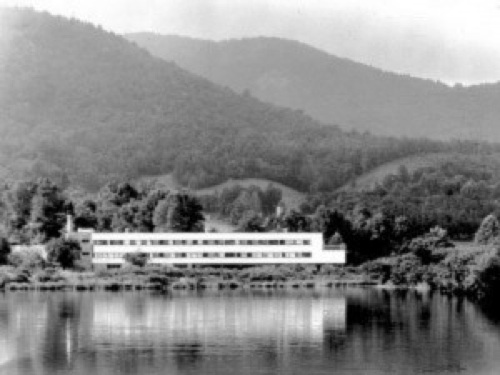
Image of Black Mountain College courtesy of the North Carolina State Archives.
BLACK MOUNTAIN COLLEGE
Olson formed a community of supporters between 1951-1956, during his period as teacher and rector at Black Mountain. It was an ideal situation for Olson; there he wrote the Maximus poems, his best known work. Martin Doberman describes Olson’s influence at Black Mountain; by 1952, Olson had converted Black Mountain into the “arts center” Albers had argued for during the 1948-1949 upheaval. An arts center with a difference: much more emphasis on literary theory than visual arts… “a frontier society, sometimes raucous and raw… bold in its refusal to assume any reality it hadn’t tested – and therefore bold in inventing forms, both in life style and art, to contain the experiential facts that supplanted traditions and agreed-upon definitions.”[xxii]
This was a rich era for American education, a sense of fraternity and irreverence was cast on students at Black Mountain but it would be short-lived. Life and art mixed together at the beautiful, nature surrounded hilltop in North Carolina. BMC was an idyllic experiment in education and community.
Olson hired his pen-pal poet-friend Robert Creeley in 1953, and together they formed an education team at Black Mountain. Their poetics were equally at home in abstract painting, photography, sculpture, dance, and architecture – almost all art forms were taught there, except jazz. The education process was a natural and spiritual function, fulfilling Olson’s imaginative “Chinese Monastery” idea of artists and scholars in the oxygen-enriched hill-top.
Among the faculty and students at Black Mountain were leading artists and thinkers of the day; Franz Klein, Robert Motherwell, Willem deKooning, Buckminister Fuller, Robert Rauschenberg, John Cage, Cy Twombly, Merce Cunningham, Philip Guston, and Ray Johnson. Poets at BMC included; Dennis Levertov, Paul Blackburn, Ed Dorn, John Wieners, Joel Oppenheimer, and photography instructors; Aaron Siskind, Arthur Siegal, Harry Callahan and Jonathan Williams. A policy of invited guest artists surrounded the students with an exciting, constantly changing mix of ideas. The influx of talent and gifted faculty energized the students through poetic osmosis – recognition of the arts process in action.
Although a wealth of revolutionary talent was present there, “Black Mountain College did not grow during his rectorship; it quite literally disappeared as parcels of its property were sold off. His students did not graduate; they drifted away to follow their own fortunes… Olson’s canon has within it a potent utterance: life is strangled by systems. Existence has an order that cannot be isolated from nature; the order is continually changing and evolving. A system is a halting of change; it seizes upon a possible order and continues to duplicate it endlessly… his vision of man is that he is a wild and passionate creature who is being lured into a false Eden of systems and institutions and who barters the realms of nature and his own primal humanity for a few material possessions.”[xxiii] Trying to keep Black Mountain afloat was a continuing challenge, not only was it a financial “black hole,” but the low morale and defections of faculty had taken their toll. Olson watched his visionary alternative to the educational system dwindle and crumble slowly away, until he was finally the last man left. He could no longer fight the demons of institutional education, what he labeled a dread and dangerous featherbed of nepotism, deadness and the club of colleagues and gerontology.[xxiv] Olson spent the remainder of 1956, by himself at Black Mountain, a lonely Buddha on the hill-top, closing down the school and attending to details. He then packed up his station wagon and returned to his family in Gloucester, New England.
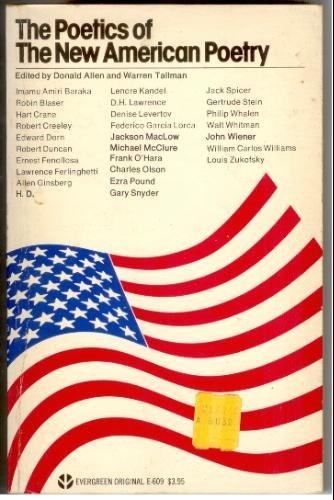
Cover of Donald Allen’s New American Poetry Anthology.
Just as finances sank to their lowest point, Olson stood at the brink of mass-exposure from the 1960 publication of Donald Allen’s Grove press anthology: New American Poetry. “It was now to become clear beyond all mistaking that Olson was bent on tearing down the old orders of language control; but if that deconstructive project would be opposed almost universally by those in entrenched power positions, to another audience of the young, interested and relatively disenfranchised it would hold great appeal.”[xxv]Discovering Olson became a rite of passage, a secret initiation into the new Greek chorus. It simply restructured the facade of poetry. Richard Grossinger recalled the magnetism of “O” in his autobiography New Moon, “I suspected what Olson was saying, though I couldn’t articulate it. It was a thing that lay at the core of ancient cultures, migrations, continental drift, and the tarot. It was the source of dreams and symbols… His poems were fields of seemingly discontinuous metaphors, but they had the spirit of bigness and cosmos about them.”[xxvi] New American Poetry was a massive success, going into twenty editions and read around the world. It created a unified landscape of the mind and culture, exposing distinct geographic literary schools. New American Poetry was a road map of the Beat Generation. 1960 was a key year for Olson, representing also the year he became a subject in Timothy Leary’s psilocybin project.
THE MAP OF HUMAN KINGS
For poet members of the Artists Workshop, the influence of ‘Projective Verse’ and Human Universe can’t be underestimated. Olson gave laws, a diagram, a map of where to go, and how to get there. The essay Human Universe traced the flatulence and lack of vigor of current poetry to our dependence on discourse introduced in the Greek age (450 B.C.). “…the universe of language that now needs to be returned to the only two universes that count, the two phenomenal ones, the two a man needs to bear on because they bear on him: that of himself, as organism, and that of his environment, the earth and planets.[xxvii] Olson describes art as being the only twin life has—its only valid metaphysic. The pollution and spoiled environment we’ve left behind is a childish accomplishment — that he damn well can, and does destroy destroy destroy energy every day. It is too much. … Man has made himself an ugliness and a bore.[xxviii] The Human Universe written in 1951, would foreshadow the profound revelations Olson would gleam while living with descendants of the Mayan people, the beginnings of his psychedelic initiation –his rebirth into an original primal force.
Having the go-ahead from Olson, Sinclair began writing the introduction to a new low-cost ($2) edition of Human Universe. It was set to be printed as an affordable trade paperback reissued by the Workshop press. The original Auerhahn Society press edition of 1965 was limited to 250 copies and sold for $25.00 (to the “culture vultures”), which kept it out of the hands of most people. In the introduction to Work #3, Sinclair calls Human Universe, the most important prose work of the decade, and in his unpublished introduction he writes:
“Olson will always have you know, that everything is there just for one thing; for use…. The “great men” (and Olson heads my own list with his twin Coltrane) have this immense utility to all of us, that they can provide us with such an example of life-force that we can use them as guides or standards in building our own lives, just as they built theirs, to be of use to all human beings on this earth.
A human universe then, is what we must have. And it is in this book, more for me than even THE MAXIMUS POEMS or DISTANCES, that spells out Olson’s greatness as a man and as an artist (poet). Just because it is always the MAN that comes first—and everything else he is or does, follows from that first simple fact that so many of us forget these days, tainted as we have been (are) by the stupid “philosophy” that is our “heritage” (our burden) or Western Man—that horrible abstract thing. “Everything is everything,” is the way I have got it from three other “great men” of this (or any) time, Pharoah Sanders, Albert Ayler and LeRoi Jones. Which means simply that we are all of what we are – nothing can be separated from that “everything.” Or as Olson has (said) it in his “Against Wisdom as Such”:
I take it wisdom like style, is the man – that it is not extricable in any sort of statement of itself; even though – and here is the catch – there be “wisdom,” that it must be sought, and that “truths” can be counted on (they are so overwhelming and so simple there does not exist the temptation to see them as “universal”). But they are, in no wise, or of the gravest loss, verbally separated. They stay the man. As his skin is, As his life. And to be parted with only as that is.
I have found out in my own life that which Olson has been trying for so long to let people know about, viz. that all of us are equally capable, that all of us, as humans, can do exactly what ourselves prepare us for, in direct proportion to the degree to which we can free ourselves (here) from the encumbrance of all the Western “thought” we have been drenched in—i.e., to the degree that we can make ourselves available to us (and then to all men) for use. Simply put, we are all “great men” and make ourselves great as we learn somehow to use ourselves to the limits of our human-ness. Or Olson again:
The EXCEPTIONAL man, the “hero,” loses his description as “genius” – his “birth” is mere instrumentation for application to the energy he did not create—and becomes, instead, IMAGE of possibilities implicit in the energy, given the METHODOLOGY of its use by men from the man who is capable precisely of this, and only this kind of intent and attention. [‘The Gate and the Center,’ Origins #1] Or to go back a paragraph: The proposition is a simple one…: energy is larger than man, but therefore, if he taps it as it is in himself, his uses of himself are EXTENSIBLE in human directions & degree not recently granted.
The “great men” of our time for me are those men who do make use of this huge human energy that each of us “possesses” but so few are hip to. And this NOW may be the greatest time ever—Pound started it off (or maybe, and I think so, Whitman before him, the huge pure energy these men brought to work in their lives). & Jelly Roll Morton I know too at that same time (turn of the century America), then Williams and later, Olson, Bird, Creeley, Pollack, Monk, the users of themselves to make a bridge for those who followed… (everything is everything).”[xxix]
Sinclair’s introduction to Human Universe was a relevant critique of the Workshop era and its future. Olson’s polemic highlighted the need and desire for culture that is compact, value based and energized. Olson discusses fable and the early need for Human Kings; mythologized heroes able to embody and pass on the great knowledge of the past. The culture of energy and free thought was incarnate within Sinclair’s poetry, jazz and rock heroes; John Coltrane, the MC5, the meat that embodied the message. This was a fight for value, authenticity and mankind’s original condition. It was all epic mythologized territory met head-on, a form of kinetic energy transposed to greater heights by the Workshop’s nose-to-the-grindstone work ethic and grassroots method.
Olson noted how the Maya were able “to put ceremony where it also belongs, in the most elementary of human acts.”[xxx] In The Human Universe, value is what’s sacred, but is kept hidden, buried under the “glowing surfaces so attractive to us all” – referring to the superficial culture of American materialism and its world of goods. That failure of America to dig into itself, to search beneath the skin, fused these poets together. Olson and Sinclair were keen organizers and sonic mapmakers, able to put down the facts—make them useful, and make one’s life inseparable from one’s words.
the poet is the pedagogue.
–Charles Olson
Cosmology of Olson Lectures available from PennSound : CHARLES OLSON RECORDED LECTURES
[from an essay by Cary Loren, 2004]
[i] “With great arms waving and punching, he bellowed about the need to kill one’s father in order to come into being oneself. His point was the father’s death is not enough in itself; a person, he said, must overwhelm, wrestle down, kill his father within himself before the son can become free… It was not a question of hate or even dislike. It was a question of cells becoming truly separate.” Elizabeth von Thurn Frawley recalls a reading by Olson as quoted in Tom Clark’s Charles Olson: The Allegory of a Poet’s Life, p.175.
[ii] Charles Olson, in Origin #1 ‘The Gate and the Center’ from Cid Corman’s Gist of Origin, (Viking, 1975) p. 4.
[iii] Charles Olson: The Allegory of a Poet’s Life, p.180.
[iv] Creeley letter to Olson 5/31/50 in Charles Olson & Robert Creeley: The Complete Correspondence, Volume 1 George F. Butterick, Ed.,(Black Sparrow Press, Santa Barbara, CA, 1980) p. 62.
[v] Charles Olson, The Human Universe and Other Essays, Donald Allan, Ed., (Grove, NY 1967) p. 52.
[vi] Charles Olson & Robert Creeley: The Complete Correspondence, Volume 1, p.79 “this is the first appearance of this famous formula, incorporated by Olson in “Projective Verse”. p. 168.
[vii] Paul Christenson, Charles Olson: Call Me Ishmael (University of Txaas Press, 1979) pp. 30-31.
[viii] Charles Olson ‘Projective Verse’ in Selected Writings of Charles Olson, Robert Creeley, Ed. (New Directions, NY 1966) p. 17.
[ix] “Pound helped verse escape the dungeon of the column inch… thus Olson thus Ginsberg thus Investigative Poetry” from Ed Sanders, Investigative Poetry (City Lights, San Francisco, 1976) p. 9.
[x] Charles Olson, Selected Writings of Charles Olson, Robert Creeley, Ed. (New Directions, NY 1967) p.19- 20.
[xi] Selected Writings p.23.
[xii] George Evans, Ed., Charles Olson & Cid Corman: Complete Correspondence 1950-1964 Vol 1, (National Poetry Foundation, University of Maine, 1987) Acknowledgements np
[xiii] Charles Olson & Cid Corman: Complete Correspondence 1950-1964 Vol 1,letetr #5, Olson to Corman, pp. 34-46.
[xiv] Ibid., #11 Olson to Corman, pp. 60-64.
[xv] Ibid., p.53, 55.
[xvi] Ibid., p.146, 147.
[xvii] Ibid, p.71-79.
[xviii] Cid Corman,The Gist of Origin 1951-1971/an anthology (Grossman/Viking, NY,1975) p.xxx
[xix] The Gist of Origin, p.xxii
[xx] Gist of Origin, p.xxii
[xxi] Paul Christenson, Charles Olson: Call Me Ishmael (University of Texas Press, 1979) p.81
[xxii] Martin Doberman, Black Mountain: An Exploration of Community (Anchor Press, NY 1975) p. 355.
[xxiii]Robert von Hallberg. Charles Olson: The Scholar’s Art (Harvard Univ. Press., 1978) pp 1-3
[xxiv] Charles Olson: The Allegory of a Poet’s Life, p. 259 Olson is being quoted from the draft of his last college catalog, Sept. 1. 1956.
[xxv] Charles Olson: The Allegory of a Poet’s Life, p, 287.
[xxvi] Richard Grossinger, New Moon (North Atlantic Press) p. 330-331
[xxvii] Charles Olson, ‘Human Universe’, Selected Writings of Charles Olson, Robert Creeley, Ed. (New Directions, NY 1967) p. 54.
[xxviii] Ibid., p. 63-64.
[xxix] John Sinclair, ‘Human Universe: The Work of Charles Olson’ unpublished, 4 pp. mss., Nd, (Bentley Historical Library, University of Michigan)
[xxx] Charles Olson, Collected Prose, (University of California Press, 1997) from ‘The Human Universe’, p.159.
Tags: Cary Loren, Charles Olson, Cid Corman, essay, Human Universe, Robert Creeley



